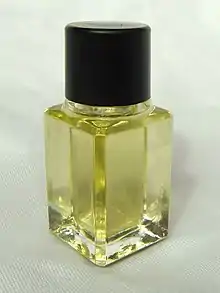Manukaöl
Das Manukaöl ist ein ätherisches Öl, das aus den Blättern und Zweigen der Südseemyrte (Manuka) durch Wasserdampfdestillation gewonnen wird.

Manukaöl
Eigenschaften
| Sicherheitshinweise | |||||||
|---|---|---|---|---|---|---|---|
| CAS-Nummer | |||||||
| |||||||
Manukaöl ist eine hellgelbe bis gelbbraune Flüssigkeit mit honigartigem Geruch[2], in Alkohol löslich und in Wasser unlöslich.[2] Die Dichte beträgt 0,994 g·cm−3[2] und der Flammpunkt liegt bei 98,6 °C.[1]
Zusammensetzung
Manukaöl kann größere Mengen Leptospermon, Calamenen und δ-Cadinen enthalten; außerdem Cadina-1,4-dien, α-Selinen, Flaveson, α-Cubeben, α-Copaen und andere Terpene.
Wirkung
Manukaöl wirkt ähnlich antibakteriell und antifungal wie Teebaumöl und ist haut- und augenreizend.[2][3]
Literatur
- N. G. Porter, P. E. Smale, M. A. Nelson et al.: Variability in essential oil chemistry and plant morphology within a Leptospermum population. In: New Zealand J. Bot. 36, 1998, S. 125–133.
- M. Harkenthal et al.: Comparative study on the in vitro antibacterial activity of Australian tea tree oil, cajuput oil, niauli oil, manuka oil, kanuka oil and eucalyptus oil. In: Pharmazie. 54, 1999, S. 460–3.
Einzelnachweise
- Datenblatt Manukaöl bei Sanabio, abgerufen am 24. April 2017.
- Datenblatt Manuka Oil bei The Essential Oil Company, abgerufen am 17. Juli 2016.
- Maria Lis-Balchin: Aromatherapy Science: A Guide For Healthcare Professionals. Pharmaceutical Press, 2006, ISBN 0-85369-578-4.
This article is issued from Wikipedia. The text is licensed under Creative Commons - Attribution - Sharealike. The authors of the article are listed here. Additional terms may apply for the media files, click on images to show image meta data.
